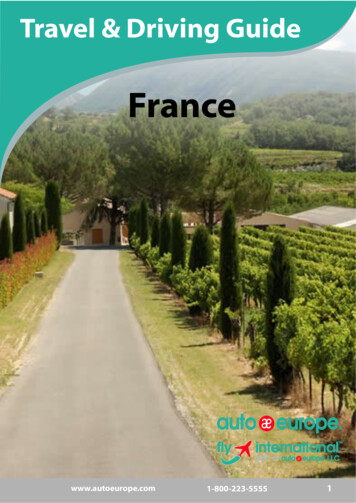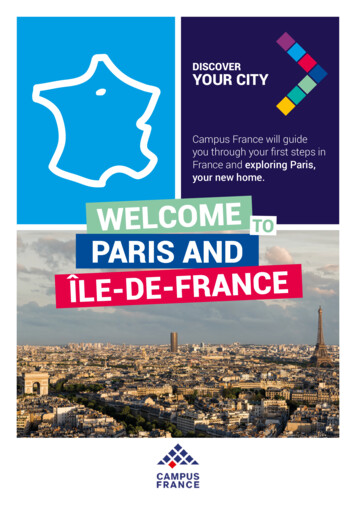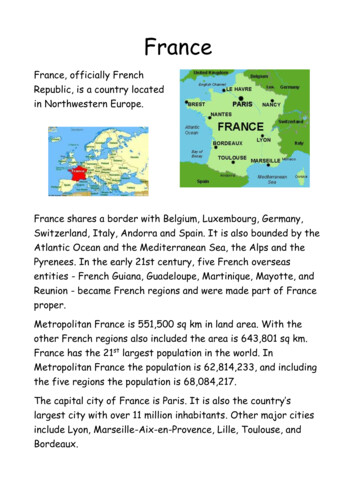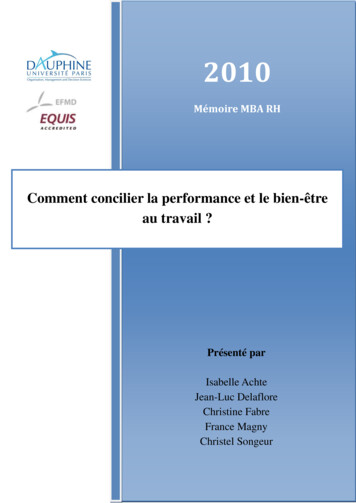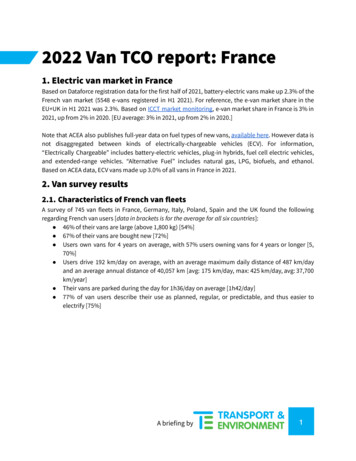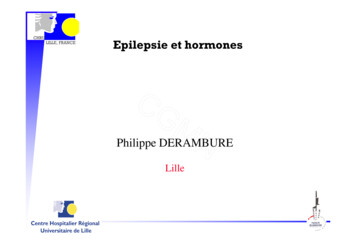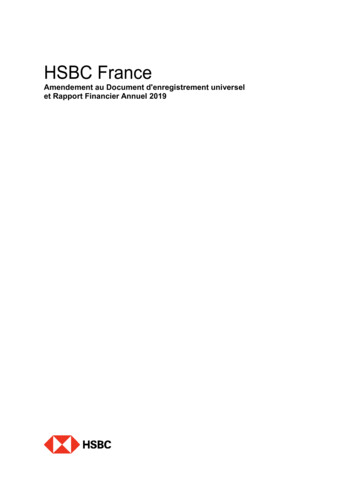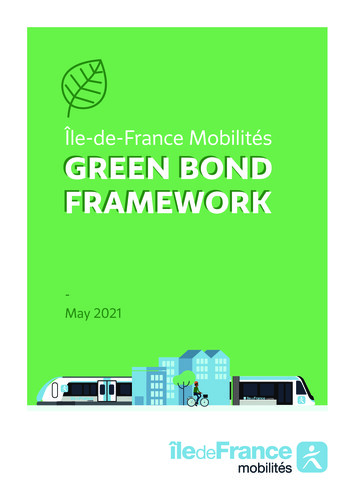
Transcription
Île-de-France MobilitésGREEN BONDFRAMEWORKMay 2021
SUMMARYI.INTRODUCTION31 - Background and missions32 - Île-de-France Mobilités’ commitment to sustainability43 - Sustainability Governance134 - Rationale for a Green Bond issuance13II.ÎLE-DE-FRANCE MOBILITÉSGREEN BOND FRAMEWORK141 - Use of Proceeds142 - Project Evaluation and Selection Process163 - Management of Proceeds174 - Reporting17a. Allocation reportingb. Impact reportingIII.EXTERNAL REVIEW191 - Second-Party Opinion192 - Post issuance external verification19VI.AMENDMENTS TO THIS FRAMEWORK20V.APPENDIX21
Section IINTRODUCTION1 - Background and missions1Île-de-France Mobilités is the Organising Authority for Mobilities (AOM) inÎle-de-France. It is in charge of organizing and developing the public passengertransport service and coordinating all policies related to mobilityat the regional level. It is a 100% local public entity with EPA Status (EtablissementPublic à caractère Administratif)Every day in Île-de-France 9.4 million trips are made by Île-de-France residents using oneof the largest public transport networks in the world. Whether for business or pleasure,with a Navigo pass (card or smartphone) or a single ticket, passengers can ride on the1,500 bus routes, 14 metro lines, 9 tram lines and 13 train and RER lines which crisscross theRegion. In the next ten years or so, the Île-de-France Mobilités network will be enhancedwith numerous extensions and new metro, tram and RER lines are under constructionat the moment, including the future lines 15, 16, 17 and 18 and the regional metro (GrandParis Express project).To operate all of these lines every day, Île-de-France Mobilités has contracts withtransport companies such as RATP, SNCF, Transdev, Keolis, RATP Dev, Savac-Lacroix andmany others, which are responsible for the proper functioning of the lines entrusted tothem and for achieving the quality of service levels set for them (punctuality, accessibility,information, safety, cleanliness).Île-de-France Mobilités designs, organises and financesthe public transport system in the Paris île-de-France regionDesigns and decides on projectsDesignto improve your public transport systemCreates bus, train, RER and tram lines,new services, Grand Paris Express, etc.And listens every dayto passengers and île-de-Franceresidents thanks to:Creates your passes and ticketsDefines the offer and pricing policythe 31 elected members of its boardModernises the transport networkand builds new linesOrganisesHolds consultations and public debatesconducts work and streers other playersEntrusts the operation of the network topublic consultationsand debatestransport operators by setting objectives(RATP group, Keolîs, Lacroix, SNCF, Transdev, etc)Ensures punctuality, accessibility, information safety,cleanliness, etc.Finances the operation and moderniastionFinancesof your public transport system meetingswith associations Centralises funding sources for the day-to-day operationof transport purchases and renovates rolling stock1. Nos missions: -missionsÎle-de-France MobilitésGREEN BOND FRAMEWORKI. INTRODUCTION3
The cost of running the current public transport amounts to more than 10 billion euroseach year. It is essentially financed in first place by employers via a tax (the mobilitypayment, formerly transport payment) and the obligation to cover 50% of the cost oftransport for their staff, then by passengers via the ticket sales, by local authorities (region,departments and City of Paris) and finally by motorists according to the polluter-paysprinciple. Île-de-France Mobilités creates various ticket types (Ticket t , Navigo Liberté ,Navigo package, Imagine’R package, Senior package, Junior package, etc.), and sets theprices.Allocation of fares, public subsidies for operation and taxes allocatedto Île-de-France Mobilités in 2019 (inclusive of all taxes)PublicsubsidiesFares incomePublic subsidiesfor social faresPassengersEmployersCompensationby RATP & SNCFfor decreaseof fares incomedue to strikes 193m 2,869m 1,003m 88m 4,065m 1,691m( 10,351m) 2,869mDISTRIBUTIONOF RESOURCESPassengers(fares) 92m 272m43% 10,351m( 10,894m)(advertising,fines,.) 543mPublic subsidies27%EMOtherresources 10,894mPassengers(fares)Transport tax 4,686mTax onenergyproductsOf which :-46% Region-50% DepartementsFUNDING OF OPERATINGEXPENDITURE28%Transporttax17% 3% Other resources1% Tax on energyproducts9%P L OY E R SRefund of subscriptionsby employersRATPSNCF(operating costs and investment programmesunder contract with Île-de-France Mobilités)49 %32 %Other transportoperators(bus, school transport)14 %Île-de-France MobilitésÎle-de-France Mobilités(operating costs includingdepreciation provisions)(investment expenditure)5%2 - Île-de-France Mobilités’ commitment tosustainabilityA. Fighting climate changeAs the organizing authority for mobility, Île-de-France Mobilités has oversight overreducing greenhouse gas emissions linked to travel: As the pilot of the Île-de-France Urban Travel Plan, As the organizing authority for mobility, on the offer and on the quality of serviceof public transport and intermodality, as well as on the renewal of fleets of publictransport vehicles.Île-de-France MobilitésGREEN BOND FRAMEWORKI. INTRODUCTION4
1 Developing public transport offer and qualityIn order to encourage more and more inhabitants to use public transport rather thantheir cars, Île-de-France Mobilités implements a policy of continuous improvement of thepublic transport offer, by acting on all levels: The renewal of rail rolling stock The development and quality of the offer and renewal of rolling stock on the existingbus network The development of the supply and quality of public transport on the developingnetwork The development of passenger services such as information or ticketing.2 The renewal of rail rolling stockIn order to improve the quality of rail transports, Île-de-France Mobilités accelerated itsambitious policy of the renewal and renovation of the rolling stock in Île-de-France in2016 (started in 2009) to significantly modernize the current stock.This policy was concretized by the adoption of a rail rolling stock (SDMR) Master Plan bythe board of directors, that defines the development trajectories of the stock by 2040.A joint diagnosis with RATP and SNCF transport operators was realized and enabled todefine structuring hypothesis in order to define the stock renewal objectives like the railrolling stock and the internal fittings lifetime, the optimized homogeneity of the rollingstock materials.The amount of the program is estimated, ultimately, at 10bn for 1100 new or renovatedtrains, the renewal in particular of lines RER B, E, D, transilien, with a first objective of 700renovated and new trains by the end of 2021.As part of the SDMR, the arrival of new materials necessarily generates a need of adaptationof the storing and maintenance facilities in order to match with the characteristics ofnew trains. Thus, Île-de-France Mobilités complements its material renewal with a largestoring/maintenance facilities development and improvement program. This program isdivided into 3 parts: The adaptation of existing infrastructures (modernization of existing facilities) The creation of new facilities in existing technicenters that will strengthen thecapacities or should this happen will compensate the capacities losses A MSOG (Maintenance site and online garage) creation program to consolidate therobustness of the operating.When the new installations are designed primarily according to the materialscharacteristics, they do not fail to take into account the environmental requirementsand the working conditions of officers, especially the improvement of the ergonomics ofworkplaces in technicenters.Île-de-France MobilitésGREEN BOND FRAMEWORKI. INTRODUCTION5
Over the period 2020-2028, the workshop and fixed facilities renewal program isestimated at 1.342bn.In parallel of the railway SDMR, Île-de-France Mobilités also launched a metro SDMR (tyreand iron). Over the period 2016-2039, the investment amounts to around 4.9bn in currenteuro, enabling to finance the renewal and renovation of tyre and rolling materials of metrolines3 The development and quality of the offer and renewal of rolling stock on the existingbus networkIn 2016, Île-de-France Mobilités launched an ambitious bus plan to develop the Île-deFrance bus network in order to create a balanced regional network adapted to the travelissues of each region. The improvements to the bus offer consist in particular of: Reinforcing the offer during peak hours in order to improve passenger comfortconditions; Reinforcing the offer during off-peak hours on weekdays and on weekends in orderto better meet the needs during these periods; Creating evening offers; Adapting routes, frequencies and amplitudes to serve new neighbourhoods, publicservices, business or leisure areas.The renewal of the Île-de-France bus and coach fleet in order to develop a network ofclean buses and thus significantly reduce emissions of local atmospheric pollutantsand greenhouse gases.Electric and bio-NGV (natural gas for vehicles) solutions have been favored for thistransition with an objective of 100% of clean buses and coaches by 2030.In order to achieve the objective of converting 10,000 buses and coaches by 2030, Île-deFrance Mobilités has implemented an energy transition strategy, based on the renewal ofrolling stock and the conversion of bus operations centers.In 2018, Île-de-France Mobilités voted for a program to accelerate the energy transition ofroad rolling stock, aiming to no longer purchase diesel vehicles. This program consisted oflaunching the energy conversion of a first wave of fifteen Bus Operations Centers. At thesame time, Île-de-France Mobilités launched its first purchases of clean, biomethane orelectric rolling stock, relying on a specialized purchasing center.Île-de-France MobilitésGREEN BOND FRAMEWORKI. INTRODUCTION6
In collaboration with Airparif, Île-de-France Mobilités has implemented campaigns tomeasure atmospheric pollutant emissions in real operating conditions on a sample ofbuses using different fuels as an alternative.In January 2021, Airparif and Île-de-FranceMobilités published the conclusion The main idea is that the renewing of more than 2000buses between 2014 and 2020 on an initial parc of 9000 buses by recent buses (electricity,hybrids, buses EURO VI, GNC) has decreased annual emission of nitrogen oxide by 1/3and less than 5% for the CO24 Develop the supply and quality of public transport on the developing networkAs the Organizing Authority for Sustainable Mobility in Île-de-France, Île-de-FranceMobilités is responsible for managing all transport services in the region and will have tooversee the opening up of the entire network to competition, including the operation ofthese new lines, which constitute the largest infrastructure and development project inEurope.In addition to the 200 kilometers of additional network, the Grand Paris Express projectincludes the construction of 68 stations into 4 new high performance automatic metrolines around Paris.Île-de-France MobilitésGREEN BOND FRAMEWORKI. INTRODUCTION7
It will enable: Suburban commuting purpose and decongestion on cross city lines target. Better connection of main areas ( universities,.) and improvement of poorlyconnected activities.5 Encouraging cycling, carpooling and car sharing: A long-term rental service for electrically assisted bicycles (VAE), Véligo, was set upby Île-de-France Mobilités. Thanks to this service, Île-de-France residents can test fora period of 6 months, extendable to 3 additional months, the use of anelectrically-assisted bicycle for their daily journeys, before deciding ifnecessary to acquire one. In order to promote the definitive switch ofÎle-de-France residents to cycling, Île-de-France Mobilités’ boardof directors decided in October 2019 to supplement the VéligoRental service with assistance to the purchase of electricallyassisted bicycles (electrically assisted classics bicycles and cargobicycles). The budget voted amounts to more than 30 M per year. A station bicycle parking offer was created as part of the implementation of the MasterPlan for Bicycle Parking in train stations and stations approved in December 2011. Thepurpose of this master plan was to deploy, near train stations and stations, secure bicycleparking spaces, in accordance with a standard of service quality that is homogeneousat the regional level. The implementation of this standard is the responsibility of thecontracting authorities as well as the transport operators to receive subsidies fromÎle-de-France Mobilités (subsidies for the creation of spaces as well as for their operation).A new scheme was approved in February 2020.Île-de-France MobilitésGREEN BOND FRAMEWORKI. INTRODUCTION8
6 An accrued vigilance of the air quality in undergoing railway spaces,where the level of fine particles in the air (which can have a strong impact on the health) isoften high. The air quality can be affected by the structure of a station, its infrastructureand the rolling stock running in this station.Île-de-France Mobilités has accrued its vigilance by including a clause in contracts madewith RATP and SNCF to monitor the air quality and to implement actions plan to reducethe exposition of its workers and clients. Also, an investment plan was defined to improvethe air quality through a better support of the renewal, the modernization and the creationof ventilation system, an improvement of the monitoring and measurements At thesame time, solutions are being sought to enable the capture of particles at the source orthe treatment of station air.B. Limiting its impact on the environment to preserve biodiversity,environments and resourcesIn order to meet the needs of biodiversity, environment and resources preservations, Îlede-France Mobilités has taken measures:1 The development of a reference framework for the environmental quality of busoperations centers (CoBs) and Trams maintenance and storage sites (TMSs) to limittheir impact on the environmentFirst of all, the choice of site must be in line with the objective of “zero netartificialisation” of the land. Thus, for the construction of new CoBs, Île-de-FranceMobilités gives priority to sites in urban renewal, already built up, located in businessor industrial zones, and situated in buildable areas (zone U). The objective is to avoidconsuming agricultural, natural or forest land as much as possible.In addition, since 2020, all new building projects under the Île-de-France Mobilitéscontracting authority must be certified to HQE INFRASTRUCTURETM.High Environmental Quality is a voluntary approach that aims to limit the environmentalimpact of a construction or rehabilitation operation, to improve the quality of life of futureusers and to achieve savings in operating and maintenance costs throughout the life ofthe building.The HQE INFRASTRUCTURESTM certification, designed by CERTIVEA, is a multi-criteriaapproach to the sustainable development of an operation. The performance objectivesdefined by the standard are organized around 4 commitments: quality of life, respect forthe environment, economic performance and responsible management.Île-de-France Mobilités sets 3 priority and mandatory targets to be integrated into theHQE INFRASTRUCTURES approach for sites and buildings: Control of the energy consumption of buildings and the project’s carbon emissions.- Obtaining the E C- Label aiming at Energy level 3 (BEPOS level) and Carbon 1 ;- For rehabilitated buildings the BBC-Effinergie Rénovation label (Cep Cref-40%)will have to be obtained, with a minimum renewable energy production of 20 Wh/m².an. Control of rainwater and water consumption- Obligation to infiltrate rainwater in situ (except for geotechnical impossibilities ofsoils / constraints related to natural risks);- 20% minimum of open ground;- 70% minimum recycling of vehicle wash water. Landscape integration and biodiversity- Implementation of compensation/accompaniment measures in situ, as soon aspossible- Minimum 40% greening of roofs;- Landscape and environmental integration of bus depots by integrating urban/rural specificities and local ecosystems;- Minimum biotope coefficient of 0.30.Île-de-France MobilitésGREEN BOND FRAMEWORKI. INTRODUCTION9
2 The development of a benchmark for the environmental quality (HQEINFRASTRUCTURES ) of exclusive right-of-way transport infrastructures in orderto limit their impact on the environment.Île-de-France Mobilites sets 3 priority and mandatory targets to be integrated into theapproach: Towards carbon neutrality and the fight against climate change- Controlling carbon emissions during the construction and operating phases willbe a core concern. Identification of sources, avoidance, search for alternatives,reduction of emissions and proposals for carbon offsets will thus be developed inour projects. Alternative management of rainwater from the platform- Obligation to infiltrate rainwater in situ (except for geotechnical impossibilities ofthe soil / constraints related to natural risks / urban spaces too small);- The use of alternative landscaping techniques will be prioritized. The TCSP line, a vector for biodiversity- Work on the ecological corridors along the linear route but also transversally inconnection with the project’s landscaping is expected.- The possible ecological compensation/accompanying measures of theinfrastructure will have to be integrated as much as possible in this approach.3 Implementation of the ERC (Avoid, Reduce and Compensate) doctrine andenvironmental proceduresWhen the avoidance and reduction approach has not made it possible toavoid any residual impact on a natural, forest or agricultural environment,Île-de-France Mobilités will implement appropriate compensation, in accordance withthe regulations and within the framework of the dedicated administrative authorizations:definition of the debt, then of the compensatory measures; identification and securing ofthe plots of land dedicated to environmental compensation; obtaining and validation bythe State services implementation and monitoring of the compensatory measures over along period of time (10 to 30 years)C. Ensuring social cohesion and solidarity between territories andgenerationsIn order to ensure social cohesion, solidarity between territories and generations andto respect the right to mobility for all, Île-de-France Mobilités has undertaken multiplemeasures and projects:1 New trams to improve the development of public transports for populations in socialdifficulty (with limited access to car or living in underserved areas). The extension of thestructuring transport network facilitates internal mobility in territories and improvesconnection with neighboring territories.The latest tramway to enter service is the tram T4.Since 2006, the T4 streetcar links Aulnay-sous-Bois (RER B) to Bondy (RER E). It now hasnine new stations that will help to open up the Clichy-Montfermeil plateau neighborhoodsand provide a connection with the future Metro 16 by 2024. Funding is divided betweenthe infrastructure: 270 M (State 37% Region 49% SNCF 14%) and the trams 100 M (Île-de-France Mobilités 100%).2 Changes in pricing for young people and seniors: Île-de-France residents over 62 (without a professional activity or with a professionalactivity strictly less than half-time) can benefit from an advantageous annual Navigopass (half-price) allowing them to travel unlimitedly in the region. The purpose is tohelp them financially and to encourage them to use public transport. Young Île-de-France residents, high school students and students under the age of26, can take advantage of a low-cost pass for unlimited travel throughout the Île-de-Île-de-France MobilitésGREEN BOND FRAMEWORKI. INTRODUCTION10
France region (Imagine’R annual pass at a 50% discount compared to the annual passfor all travelers). Starting in 2020, this unlimited travel option will also be offered tochildren under 11 years of age with the creation of an Imagine’R Junior pass, at a priceof 24 for the year.3 Making the public transport network accessible to everyone from the road to the train.As of today, trains, trams and buses deployed on the network fully integrate issues relatedto accessibility.Île-de-France Mobilités was designated in 2006, as the competent authority in Île-deFrance for the preparation of the master plan for the accessibility of transport services(SDA), the purpose of which is to ensure the accessibility of public transport services andnetworks to people with reduced mobility through the progressive implementation ofappropriate measures.The plan provides for the accessibility of 266 railway stations, 207 of which are underthe control of SNCF Réseau and SNCF Voyageurs for a target cost of 1.454 billion at01/2009 value, including the remaining stations to be made accessible.The schedule of the SDA is to be fully implemented before 2025 with 209 stationsaccessible.4 Developing carpooling: Carpooling consists of any movement in car in which the drivercarries one or more passengers regardless of their reason for traveling and their age. Thispractice is still limited in Île-de-France for travel related to work. Since 2017, Île-de-FranceMobilités has been implementing a carpooling (mainly work related) financial incentivescheme as part of the “Tous ensemble pour le covoiturage” operation.5 Offering mobility solutions in the less heavy territories: Transport on-demand (TAD) service in sparsely populated areas of the region. Thisservice is based on the circulation of vehicles adapted to the flow of travelers andcirculating only when a need is expressed. Created in 2019 with a long-term view, abooking platform facilitates the emergence of new TADs and the integration of newservices is envisaged. Parcs Relais are car parks set up near a train station to encourage motorists to usepublic transport to get to the city center or to Paris. The Parc Relais master plan,approved by Île-de-France Mobilités in 2006, sets the conditions for the award ofthe “Parc Relais” label and thus on how to benefit from subsidies for their creation,extension and renovation. Since March 1, 2019, the Annual Navigo Pass includes afree subscription to “Parcs Relais” to encourage the use of public transport.Île-de-France MobilitésGREEN BOND FRAMEWORKI. INTRODUCTION11
D. The Development of all human beings1 Improving transport conditions with the renewal of rolling stock: The condition of therolling stock is determinant in the quality of service, both for comfort during the journeyand for the regularity of operation, by limiting the risk of breakdown. Île-de-FranceMobilités has carried out an ambitious program of more than 10bn for the modernizationof all the trains of the region.2 More means to ensure the safety of travelers: Securing the network is an essentialstake for the Île-de-France population and for the attractiveness of the region. Thus, Îlede-France Mobiltiés has multiplied measures and plans to reinforce users’ security: A new safety plan in public transports was adopted in 2019 and was based ona reinforcement of the human security presence, the technological axe and thedevelopment of new perspectives of security with AI. Measures to fight against harassment in public transport through in particulara reinforcement of human presence with a specific formation on the support ofharassment victims, a generalization of the video protection and new measures toreport a case of harassment (call point, active service 24 hours a day, etc.) more easily.A campaign to combat harassment in transport led by Île-de-France Mobilités, theÎle-de-France region, the RATP and SNCF Transilien, was renewed in 2019 principallyto raise awareness among travelers about the subject and also to make known thetools implemented for reporting harassment. The descent on demand service on certain bus lines from 10 p.m., allowing anyonewho requests it to get off between two bus stops in order to get closer of their home.The service is gradually being extended on the bus network.Île-de-France MobilitésGREEN BOND FRAMEWORKI. INTRODUCTION12
E. The transition towards a circular economyThe circular economy is a business model of making the most of resources across theentire business cycle, from design to recycling, taking an approach to educate consumersand extend the lifespan of products. Île-de-France Mobilités has been engaged in thistransition:1 As part of the energy transition policy for the Île-de-France bus and coach fleet, an objectivehas been set to have 75% of Île-de-France buses run on bio methane by 2030. Plans andstrategies have come together to boost this transition around the main deposits likely tobe used to produce bio-methane: agricultural and forestry biomass, and waste (e.g. Îlede-France residents’ bio-waste).2 As part of the environmental quality approach that it has initiated for the bus operationscenters, Île-de-France Mobilités has initiated an HQE certification process focused aroundthree priority targets: controlling energy consumption and the carbon emissions of theproject, controlling rainwater and water consumption, as well as landscape integrationand biodiversity. These targets thus participate in reducing the use of resources for futureuses of the building and help reduce its ecological footprint.3 - Sustainability GovernanceEach year, in accordance with the provisions of Articles L5217-10-2 et D5217-8 of theGeneral Code of Local Authorities, Île-de-France Mobilités submits a report on thesituation with regard to sustainable development. This report covers all the operations,policies and programs of Île-de-France Mobilités that are likely to improve the situationwith regard to sustainable development. The report is presented and submitted tothe Board of Directors of Île-de-France Mobilités for approval as part of the budgetaryorientation debates. This report is available on the Île-de-France Mobilités website.4 - Rationale for a Green Bond issuanceTransport is the activity that contributes the most to France’s greenhouse gas (GHG)emissions. In 2019, it accounts for 31% of France’s GHG emissions. 2In Île-de-France, the three major sources of atmospheric pollutants are road transport, theresidential sector and the tertiary sectors (mainly heating).Road transport is responsiblefor more than 29% GHG emissions in Île-de-France. 3Low-carbon transport therefore has a key role to play in the environmental transition inÎle-de-France and more widely in France.The energy transition is a major challenge for Île-de-France Mobilités, which has alwaysbeen committed to promoting low-carbon transport. The Île-de-France Mobilités GreenBond Framework is dedicated to the accessibility and promotion of low carbon andsustainable transport. It is an opportunity to highlight the company’s CSR strategy andinitiatives that contribute to climate change mitigation.The aim will also be to diversify Île-de-France Mobilités’ investor base and engage in asustainable dialogue with socially responsible investors.2. République Française (2021), rapport sur l’état de l’environnement : de-gaz-a-effet-de-serre-du-secteur-des-transports / 3.Airparif (2020), Émissions et consommations 2018 en Île-de-France (estimations faites en 2020) ion/les-emissionsÎle-de-France MobilitésGREEN BOND FRAMEWORKI. INTRODUCTION13
Section IIÎLE-DE-FRANCEMOBILITÉS GREENBOND FRAMEWORKIn order to meet the commitments described above, and finance projects that willdeliver environmental benefits to support Île-de-France Mobilités business strategyand vision, Île-de-France Mobilités has elected to create a Green Bond Framework(the “Framework”), under which it can issue Green Bond(s).This Framework is in accordance with the ICMA Green Bond Principles (GBP) 2018 4as well as with the EU Green Bond Standard 5 requirements.In alignment with these Principles, for each Green Bond(s) issued,Île-de-France Mobilités asserts that it will adopt the following, as set out in thisFramework:1. Use of Proceeds2. Process for Project Evaluation and Selection3. Management of Proceeds4. Reporting1 - Use of ProceedsAn amount equivalent to the net proceeds raised from any Île-de-France Mobilités GreenBond issued under this Green Bond Framework will be allocated, in part or in full, tofinance the following eligible projects. The eligible green projects contribute to the EUenvironmental objectives and the eligibility criteria are in alignment with the TechnicalScreening Criteria of the EU Taxonomy delegated acts that were published in April 2021,DNSH principles are applied to the selected projects and minimum social safeguards aretaken into consideration 6 (details in annexes).All the following eligibility criteria are aligned with the Green Bond Principles Project Category Clean Transportation:4. Green Bond Principles (GBP) 2018 - ability-bonds/green-bond-principles-gbp / 5. EUGreen Bond Standard - d-standard en/ 6. Sustainable finance – EU classification system for green investments - ementary-acts/implementing-and-delegated-acts enÎle-de-France MobilitésGREEN BOND FRAMEWORKII. ÎLE-DE-FRANCE MOBILITÉS GREEN BOND FRAMEWORK 14
Eligible sub-categoryEligible assets/projectsEligibility CriteriaAlignment with theEU Taxonomy (No.)Renovation andrenewal of surfacepublic transportrolling stock Ac
with a Navigo pass (card or smartphone) or a single ticket, passengers can ride on the 1,500 bus routes, 14 metro lines, 9 tram lines and 13 train and RER lines which crisscross the . The renewal of the Île-de-France bus and coach fleet in order to develop a network of clean buses and thus significantly reduce emissions of local atmospheric .


